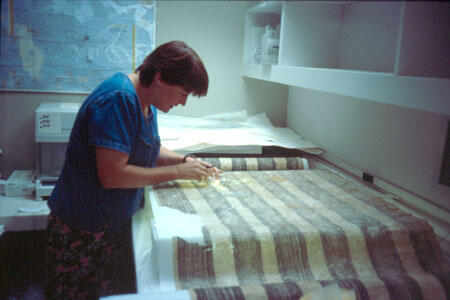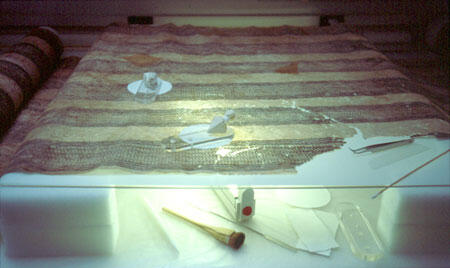The Peabody Museum has exhibited objects from its vast Pacific Islands collections since the opening of the present museum building in 1877. Early exhibits often featured tapa as background for the display of other material culture from the Pacific.

For many years, research and staff access to the museum’s tapa collections was compromised because of inadequate storage. Unfortunately, some collections were also poorly documented. In 1997 the Conservation Department initiated a survey of the tapa collections to examine existing storage and environmental conditions and to define preservation problems. In 1998, the museum was fortunate to receive funding for the preservation of its tapa from the Institute of Museum and Library Services (IMLS, a federal agency) under its Conservation Project Support Program. The IMLS grant, coupled with museum funds, made it possible to photograph and better document the tapa collections through the analysis of cloth components and production techniques. Conservation treatments were initiated that included surface cleaning, crease reduction by means of local humidification, and stabilization (with repair of tears and losses when possible). Finally, storage conditions for 275 individual cloths were improved.

Objects made of organic materials, such as leather, wool, cotton, paper, and barkcloth, are far more susceptible to degradation than inorganic materials, such as stone and ceramic. Because they are made of plant fibers, tapa present several challenges to conservators. The conservators who treated the cloths shown here were specially trained in textile, object, and paper preservation. The Code of Ethics and Guidelines for Practice of the American Institute for Conservation of Historic and Artistic Works guided treatments throughout the tapa project.

Museum preservation today involves both preventive measures that reduce risks or sources of damage to objects and conservation treatment of objects. Key factors affecting the preservation of tapa include:
- Improper handling, storage, or display, which can result in tears or losses
- Inappropriate or fluctuating temperature and relative humidity levels that may foster mildew or cause drying and cracking
- Light exposure, causing irreversible damage or color fading
- Insect pests that feed on the tapa and cause holes
- Airborne pollutants such as fine soot particles from heating systems or urban sources, which may result in acidic surface deposits and soiling